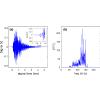当前位置:
X-MOL 学术
›
Phys. Rev. E
›
论文详情
Our official English website, www.x-mol.net, welcomes your feedback! (Note: you will need to create a separate account there.)
Slow dynamic elastic recovery in unconsolidated metal structures.
Physical Review E ( IF 2.4 ) Pub Date : 2020-07-01 , DOI: 10.1103/physreve.102.012901 John Y Yoritomo 1 , Richard L Weaver 1
Physical Review E ( IF 2.4 ) Pub Date : 2020-07-01 , DOI: 10.1103/physreve.102.012901 John Y Yoritomo 1 , Richard L Weaver 1
Affiliation

|
Slow dynamic nonlinearity is widely observed in brittle materials with complex heterogeneous or cracked microstructures. It is seen in rocks, concrete, and cracked glass blocks. Unconsolidated structures show the behavior as well: aggregates of glass beads under pressure and a single glass bead confined between two glass plates. A defining feature is the loss of stiffness after a mechanical conditioning, followed by a logarithmic-in-time recovery. Materials observed to exhibit slow dynamics are sufficiently different in microstructure, chemical composition, and scale (ranging from the laboratory to the seismological) to suggest some kind of universality. There lacks a full theoretical understanding of the universality in general and the log(time) recovery in particular. One suspicion has been that the phenomenon is associated with glassy grain boundaries and microcracking. Seminal studies were focused on sandstones and other natural rocks, but in recent years other experimental venues have been introduced with which to inform theory. Here, we present measurements on some simple metallic systems: an unconsolidated aggregate of aluminum beads under a confining pressure, an aluminum bead confined between two aluminum plates, and a steel bead confined between steel plates. Ultrasonic waves are used as probes of the systems, and changes are assessed with coda wave interferometry. Three different methods of low-frequency conditioning are applied; all reveal slow dynamic nonlinearities. Results imply that glassy microstructures and cracking do not play essential roles, as they would appear to be absent in our systems.
中文翻译:

未固结金属结构中的动态弹性恢复缓慢。
在具有复杂的异质或破裂微观结构的脆性材料中,广泛观察到缓慢的动态非线性。在岩石,混凝土和破裂的玻璃砖中都可以看到它。未固结的结构也表现出这种行为:在压力下玻璃珠的聚集体和限制在两个玻璃板之间的单个玻璃珠。一个明确的特征是机械调节后刚度的损失,然后是对数的时间恢复。观察到表现出缓慢动力学的材料在微观结构,化学组成和规模(从实验室到地震学)的范围内都存在很大差异,表明某种通用性。普遍缺乏普遍的理论理解,尤其是对数(时间)恢复。一种怀疑是这种现象与玻璃状晶界和微裂纹有关。开创性的研究集中在砂岩和其他天然岩石上,但是近年来,引入了其他实验场所,以为理论提供参考。在这里,我们介绍一些简单的测量金属系统:在密闭压力下未固结的铝珠集合体,铝珠限制在两个铝板之间,钢珠限制在钢板之间。超声波被用作系统的探针,并通过尾波干涉测量法评估变化。应用了三种不同的低频调节方法:都显示出缓慢的动态非线性。结果表明,玻璃状的微结构和裂纹没有发挥重要作用,因为它们似乎在我们的系统中不存在。
更新日期:2020-07-01
中文翻译:

未固结金属结构中的动态弹性恢复缓慢。
在具有复杂的异质或破裂微观结构的脆性材料中,广泛观察到缓慢的动态非线性。在岩石,混凝土和破裂的玻璃砖中都可以看到它。未固结的结构也表现出这种行为:在压力下玻璃珠的聚集体和限制在两个玻璃板之间的单个玻璃珠。一个明确的特征是机械调节后刚度的损失,然后是对数的时间恢复。观察到表现出缓慢动力学的材料在微观结构,化学组成和规模(从实验室到地震学)的范围内都存在很大差异,表明某种通用性。普遍缺乏普遍的理论理解,尤其是对数(时间)恢复。一种怀疑是这种现象与玻璃状晶界和微裂纹有关。开创性的研究集中在砂岩和其他天然岩石上,但是近年来,引入了其他实验场所,以为理论提供参考。在这里,我们介绍一些简单的测量金属系统:在密闭压力下未固结的铝珠集合体,铝珠限制在两个铝板之间,钢珠限制在钢板之间。超声波被用作系统的探针,并通过尾波干涉测量法评估变化。应用了三种不同的低频调节方法:都显示出缓慢的动态非线性。结果表明,玻璃状的微结构和裂纹没有发挥重要作用,因为它们似乎在我们的系统中不存在。



























 京公网安备 11010802027423号
京公网安备 11010802027423号